
The Heritage of the Mercedes-Benz Brand
by Holly Reich
You
may know Stuttgart, Germany for its art museums, opera, ballet, gourmet food and
trendy shopping. Stuttgart is also the home of the Mercedes plant, Mercedes Museum
and the Mercedes Classic Car Center. In a town that uses Mercedes taxi cabs as
transport, and spawns a large percentage of University graduates who go to work
for the company, Mercedes is practically a household word. Even if you're not
a Mercedes lover, the experience is something that you won't forget.
The
MERCEDES-BENZ MUSEUM "Classic
cars are very emotional you don't hear people complain about the smell of
oil," noted Ulrich Loechner, manager of the Mercedes Benz museum, as he began
a recent tour of the property. The museum which houses 80 vintage cars marks the
history of the three main players of the company -- Gottlieb Daimler, Karl Benz,
Emil Jellinek and Wilhelm Maybach and the vehicles they created. The
setting is a hi-tech-looking lofty space with floor to ceiling windows and racetracks
(ramps) that gracefully wind up to different levels and different eras in the
world of automobiles. Starting
on the main floor, there's the first motorcycle from 1886, with a wooden riding
saddle. This was also known as the first heated seat, yet only by default. The
open flame of a Bunsen burner (part of the power system) was unfortunately positioned
directly beneath the saddle. Story has it that Gottlieb Daimler (as in DaimlerChrysler)
had to jump off several times while testing the two-wheeler. Loechner
also told us that the first motor-driven buggy from 1888 was tested by the wife
of Carl Benz (as in Mercedes-Benz). She packed up her two boys and left home for
a day. When she needed to stop for gasoline she got it at the local pharmacy.
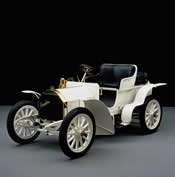 |
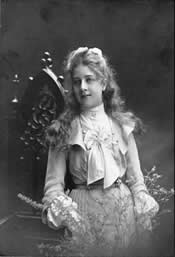 |
Mercedes
Simplex (top) and Mercedes Jellinek, after whom the automotive company was named.
Photos courtesy of Mercedes-Benz. | The
museum's first floor also features the Simplex, considered the first Mercedes
that was built in 1901. Designed by Wilhelm Maybach it had 35hp and stood long
and low to the ground. Emil Jellinek, an Austrian businessman, was instrumental
in the development of the vehicle. When he commissioned this sports car, he exclaimed,
"I don't want the car of today or the car of tomorrow, but the car of the
day after tomorrow."
Jellinek bought a fleet of 36 and named them Mercedes (in Spanish this means grace)
after his young daughter. What
Mercedes calls its DNA is exhibited in meticulously hand-painted buggies with
details including built-in candleholders and bars, exquisite leather interiors
with megaphones to talk with the drivers. Several ones had seats facing backwards
(with footsteps to get into them) called "mother-in-law" seats. Traveling
up the ramp, the low, lean and chrome-plated sports cars of the 20's and 30's
(rumble seats included) are the famous Silver Arrow of 1939 and Hirohito's car
-- the 770, or the "grosse Mercedes" with armored plating and a V8 engine. It's
about this point that even if you never said the word horsepower in your life
you become a car lover. I was having visions of myself in buggies wearing kid
gloves and structured white suits with tall ankle-wrapped heels, or tooling around
in a 30's roadster with a long chiffon scarf. The designs are inspiring.
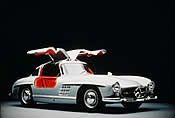 |
1954
- 1957 300 SL 'Gullwing'.
Photo courtesy of Mercedes-Benz. |
For instance,
there's the 300SL Gullwing from the 50's with
doors that open like wings from
the center, or the Mercedes-Benz 600, the car that carried several popes, speedsters
that look like batman, or the racing car that had such a snug seat the driver
had to be lifted in by a crane. This is the stuff that makes you a car junkie. The
New Mercedes-Benz museum, which has design elements of New York's Guggenheim,
will open the spring of 2006 along with the world soccer championships in Germany.
This museum will hold up to 250 classic cars. To
note: Use the headsets for the Museum tour so you can hear the stories behind
the vehicles. THE
GOTTLIEB DAIMLER MEMORIAL Set
on the park grounds of Gottlieb Daimler's former home, the greenhouse holds original
tools and drawings of Gottlieb and Wilhelm Maybach. This is where it all began.
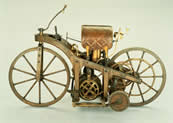 |
Daimler
Riding Car.
Photo courtesy of Mercedes-Benz. | Daimler
and Maybach worked 24/7 in absolute secrecy creating their first engine. Even
Daimler's family and staff didn't have a clue to the goings on. At one point a
suspicious gardener contacted the police claiming that the greenhouse was a money-counterfeiting
workshop. When they found only tools and engine components during their nighttime
search, the inventors were left alone to work. In 1885 they received a patent
on an upright engine which they named "grandfather clock", a singlecylinder
engine light and compact enough to fit into a two-wheeler "riding car".
This was the first motorcycle that you see at the museum. In
the summer of 1886 the pair mounted the engine into a horseless carriage and drove
around town much to the shock of observers. People were so spooked by the technology
that Daimler and Maybach decided to do future testing on the Neckar River. Thus,
they mounted the motor in a boat and the Neckar
became the first motorboat.
THE CLASSIC CENTER
It
might be fun to rent a car for the day and travel just outside the city to Fellback.
Take the route via the Autobahn where there are no speed limits.
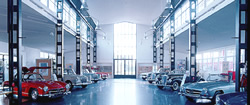 |
Classic
Mercedes vehicles for sale at the Mercedes Classic Center.
Photo courtesy
of Mercedes-Benz. | The
Classic Center sells 30-50 rare cars a year so the vehicles are always changing.
We saw the Mercedes that Jackie Onassis drove and a gorgeous chocolate brown 1935
Mercedes 500 K from the years valued at $3.8 million. The
Classic Center is also where people come to have their classic cars worked on.
Over 40,000 spare parts are available through the shop, which purrs with mechanics
hand tooling the classics. Unlike any other mechanics shop I have been in, the
environment is so clean you could picnic on the floor and so quiet you can hear
your own voice. For the collector the Center stocks hard to find shirts, clothes,
watches, miniature model cars, and Mercedes books. In
a special garage not open to the public Die Heiligen Hallen (the secret halls)
we were witness to the unveiling of several famous cars including Lady Di's chauffeur
driven car and the M-class jeep from the movie Jurassic Park. Someone in
our group even thought they spotted the fender of a concept car. PLANT
TOURS:
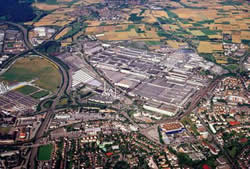 |
An
erial view of the Sindelfingen plant.
Photo courtesy of DaimlerChrysler. |
The Sindelfingen
plant also just outside of Stuttgart is also open for tours. We visited the stamping
facility where 10-16 foot-tall robots use dies to stamp out pieces of the car
that eventually end up as door parts or structural members. The parts are then
sent to the assembly line where people and robots put the parts together. At the
finishing plant there are mostly engineers working hands-on to do tasks that include
the stitching of leather seats or refining touches to the instrument panel.
FOR MORE INFORMATION ON MERCEDES HISTORY, GO
TO: www.mbusa.com/classic.
FOR MORE INFORMATION ON STUTTGART, GO TO:
http://www.stuttgart-tourist.de/english/index.html.
|